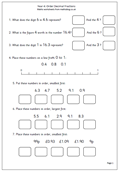 It is important that children recognise that the value of a digit depends on its place in the number – otherwise we could only possibly have 9 numbers and zero! So the digit 1 in 120 has a different value than the 1 in 210. It is, of course ten times bigger as it is 100 rather than 10.
It is important that children recognise that the value of a digit depends on its place in the number – otherwise we could only possibly have 9 numbers and zero! So the digit 1 in 120 has a different value than the 1 in 210. It is, of course ten times bigger as it is 100 rather than 10.
By Year 4 children should be applying this idea to decimals. The first column to the right of the decimal point is tenths so the 1 in 2.1 has a value of one tenth.
This maths worksheets looks at both place value and ordering simple decimal fractions. Children probably come across decimal fractions more often with money than any other area and it is a really good way to show place value eg one penny is £0.01, or one hundredth, whilst 10p is £0.10 or one tenth of a pound. (Notice we always put two digits after the decimal when using money, but not at other times.)
I like the clear layout of these sheets. They would be useful for tutoring children in key topics of difficulty – fractions, decimals and percentages are often a problem area.
I love the clear layout of these sheets. It is very useful. 🙂